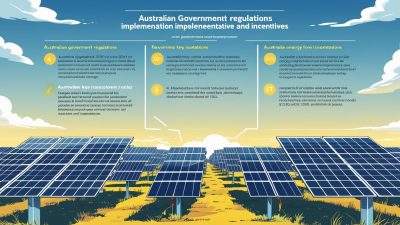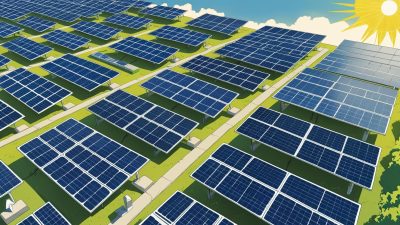Government Incentives for Solar Farms in Australia
Bloggerbanyumas.com – As the global push for renewable energy intensifies, Australia has positioned itself as a leader in solar energy development. With abundant sunshine and an increasing demand for sustainable energy solutions, the country’s solar farms are playing a crucial role in the renewable energy transition. To support the growth of solar energy, the Australian government has introduced a variety of incentives aimed at encouraging solar farm development. In this comprehensive 2025 guide, we explore the various government incentives available for solar farms in Australia, examining the latest policies, financial support mechanisms, and long-term benefits that developers and investors can leverage.

The Australian government’s commitment to renewable energy is evident in the generous subsidies, tax incentives, and other financial assistance programs designed to promote clean energy projects. Solar farms, in particular, have benefited from these initiatives, driving their expansion and integration into the nation’s energy grid. These incentives not only reduce the financial burden on solar farm developers but also align with Australia’s renewable energy targets for 2025 and beyond. In this article, we delve deep into the specific incentives, the eligibility criteria, and the impact these programs have on the solar energy industry, providing an essential resource for anyone interested in pursuing solar farm development in Australia.
The Role of Government Incentives in Solar Farm Development
Government incentives are central to accelerating the transition to renewable energy. In Australia, these incentives help overcome several barriers to solar farm development, including the high upfront costs of land acquisition, equipment, installation, and grid connection. By reducing financial risks, these programs encourage private sector investment and provide a stable environment for long-term solar energy projects. They also foster technological innovation, stimulate job creation, and contribute to the overall sustainability of the national power grid.
Australia’s solar farm industry has expanded significantly in recent years, with an increasing number of large-scale solar projects coming online. The support from the government has been pivotal in this growth, particularly as the country seeks to meet its renewable energy generation targets and reduce reliance on fossil fuels. Government incentives help ensure that solar farms remain competitive with traditional energy sources, despite the high initial capital investment typically required for solar infrastructure.
How Government Incentives Are Shaping Australia’s Solar Industry
As Australia moves toward a renewable energy future, government incentives are increasingly tailored to address the specific needs of solar farms. These incentives are designed to offset some of the financial risks associated with solar farm development, which can include challenges in financing, grid connection, and infrastructure development. With the nation’s energy market undergoing a significant transformation, these incentives are helping to drive innovation and improve the overall efficiency of solar energy production. They are also contributing to Australia’s broader environmental goals, such as reducing greenhouse gas emissions and transitioning to a low-carbon economy.
The government’s incentives for solar farms are aligned with international best practices, ensuring that Australia remains competitive on the global renewable energy stage. As the market for solar energy grows, so too does the need for effective policy frameworks that support sustainable development. The following sections outline the specific types of government incentives available for solar farms in Australia in 2025, helping developers understand how to access financial support for their projects.
Key Government Incentives for Solar Farms in Australia (2025)
1. The Renewable Energy Target (RET)
One of the most significant government incentives for solar farms in Australia is the Renewable Energy Target (RET). The RET is a policy initiative aimed at reducing Australia’s carbon emissions by promoting the use of renewable energy sources. Under the RET, Australia has set a target to achieve 33,000 gigawatt hours (GWh) of renewable energy by 2025, which includes the contribution of solar power. Solar farms play a critical role in meeting this target, and developers can benefit from the RET by receiving Renewable Energy Certificates (RECs) for the electricity generated by their solar farms.
RECs are tradeable certificates that represent the generation of one megawatt-hour (MWh) of renewable energy. Solar farm operators can sell these certificates to businesses and individuals who need to meet their renewable energy obligations. The sale of RECs provides a financial incentive for developers and helps make solar projects more economically viable. In 2025, the RET will continue to provide substantial support for solar farm developers, especially as the country works to accelerate its transition to renewable energy.
2. The Clean Energy Finance Corporation (CEFC)
The Clean Energy Finance Corporation (CEFC) is another key government initiative designed to support solar farm development. The CEFC provides funding for renewable energy projects through loans, equity investments, and guarantees. The CEFC focuses on high-impact, large-scale renewable energy projects, and solar farms are a major beneficiary of this funding. In 2025, the CEFC is expected to continue offering financing options that make it easier for solar farm developers to access the capital they need for construction and operation.
By offering lower-interest loans and long-term financing options, the CEFC helps reduce the financial burden on developers and makes solar farms more attractive to investors. The CEFC’s role in financing solar energy projects is crucial, particularly as the demand for renewable energy continues to grow. Solar farms benefit from the CEFC’s financial support by securing favorable financing terms that lower the cost of capital and improve project feasibility.
3. The Australian Renewable Energy Agency (ARENA)
The Australian Renewable Energy Agency (ARENA) plays a critical role in supporting solar farm development by funding research, innovation, and technology deployment in the renewable energy sector. ARENA provides competitive grants for projects that demonstrate technological advancements, improve efficiency, and reduce costs in solar energy production. These grants are designed to help developers overcome the financial and technical challenges associated with solar farm projects.
In 2025, ARENA will continue to fund solar farm projects that demonstrate innovation and scalability. ARENA’s focus on technology-driven solutions means that developers who are looking to incorporate cutting-edge technologies, such as advanced energy storage systems and smart grid integration, can benefit from additional funding support. ARENA’s funding is particularly valuable for solar farms that are working to push the boundaries of what is possible in solar energy generation.
4. State-Based Solar Incentives
In addition to national programs, state governments in Australia offer various incentives to support solar farm development. These incentives vary by state but often include grants, subsidies, and tax breaks for solar energy projects. Some states also offer financial support for grid connection, land acquisition, and environmental assessments, which can significantly reduce the upfront costs of solar farm development.
For example, the state of New South Wales (NSW) offers the Renewable Energy Infrastructure Fund, which provides funding for renewable energy projects, including solar farms. Similarly, the Victorian government has introduced the Renewable Energy Target, which supports the development of large-scale solar projects in the state. Developers should consult with local authorities to explore the specific incentives available in their region and identify opportunities to access additional funding support.
5. Tax Incentives and Depreciation Benefits
Australia offers a range of tax incentives that can significantly reduce the financial burden on solar farm developers. One of the most important tax benefits is the ability to claim accelerated depreciation on solar farm assets. Under the Australian tax system, developers can depreciate the value of their solar farm infrastructure over a short period, allowing them to recover their capital costs more quickly.
In addition to depreciation, solar farms may also qualify for various other tax incentives, such as exemptions from goods and services tax (GST) on certain equipment and services related to solar farm development. These tax incentives make it more financially feasible for developers to invest in solar energy infrastructure and help ensure that solar farms remain competitive with other energy sources.
6. Power Purchase Agreements (PPAs) and Feed-in Tariffs
Power Purchase Agreements (PPAs) and feed-in tariffs are long-term contracts between solar farm developers and energy buyers (such as utilities or large corporations). These agreements provide a stable and predictable revenue stream for solar farm operators by guaranteeing a fixed price for the electricity generated by the farm. In Australia, PPAs and feed-in tariffs are often supported by government policies and can be a crucial source of financial stability for solar farm projects.
In 2025, solar farm developers can continue to benefit from these agreements, which provide a secure financial foundation for large-scale renewable energy projects. PPAs and feed-in tariffs also help mitigate the risks associated with fluctuating energy prices, allowing solar farm operators to plan for the long term and attract investors.
The Future of Government Incentives for Solar Farms in Australia
As Australia works toward achieving its renewable energy targets for 2025 and beyond, government incentives for solar farms will continue to play a vital role in the industry’s growth. The shift to a low-carbon energy future is accelerating, and solar farms are central to this transformation. The government’s support for solar energy projects will ensure that developers can overcome the financial and technical challenges of solar farm development, ultimately helping Australia reach its clean energy goals.
Looking ahead, government incentives for solar farms will likely evolve to reflect changing market conditions, technological advancements, and emerging policy priorities. In 2025 and beyond, solar farm developers should stay informed about the latest incentives and take advantage of the opportunities available to them. With continued support from the Australian government, the future of solar energy in Australia looks bright, with solar farms playing a central role in the nation’s transition to a sustainable energy future.
By leveraging government incentives, solar farm developers can reduce costs, improve project feasibility, and contribute to Australia’s renewable energy goals, paving the way for a cleaner, more sustainable energy future.












